Annual vet exams will help ensure pet turtles’ long-term health.
Aquatic turtles are very popular pets, and many species are colorful, modest in size, and intelligent. However, it is important to understand the long-term responsibility that comes with caring for an aquatic turtle.
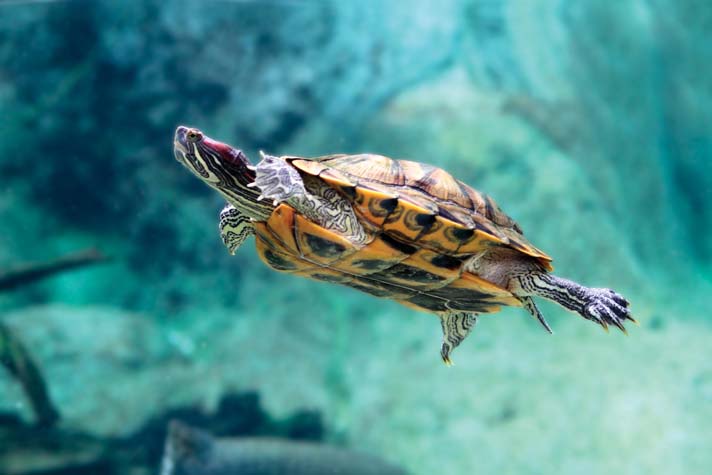
Dr. Charles Innis
Some turtles, including painted turtles (Chrysemys picta ssp.), shed the thin keratin scutes of the shell as they grow; this should not be confused with an infection of the shell.
When cared for properly, turtles should live for decades. Most species require rather large tanks with clean water and appropriate water volume. As a result, caring for aquatic turtles can be more labor intensive than caring for terrestrial pet reptiles such as tortoises, snakes, or lizards. Often, the required care and long lifespan of aquatic turtles leads owners to no longer want to care for them. Many unwanted turtles are surrendered to animal shelters or released into the wild, often in non-native habitats where they can cause problems as invasive species.
Pet owners should fully understand the commitment required in properly caring for pet aquatic turtles. Thorough research regarding the proper temperature, diet, lighting, tank size, and adult size should be conducted prior to selecting a species. Fortunately, there is now an abundance of good information and useful products to enhance the care of captive turtles.
Popular pet aquatic turtle species include many of the North American species of the family Emydidae, such as painted turtles (Chrysemys picta), map turtles (Graptemys spp.), cooters and sliders (Pseudemys and Trachemys spp.), and many of the side-necked turtles (e.g., Emydura subglobosa). Many other species are kept by advanced hobbyists. As for all reptile pets, owners should ensure that it is legal to keep a particular species in the area in which they reside, and that specimens have been acquired legally. Certain aquatic turtle species, such as sea turtles, are federally protected and cannot be kept as pets in the U.S. and many other countries.
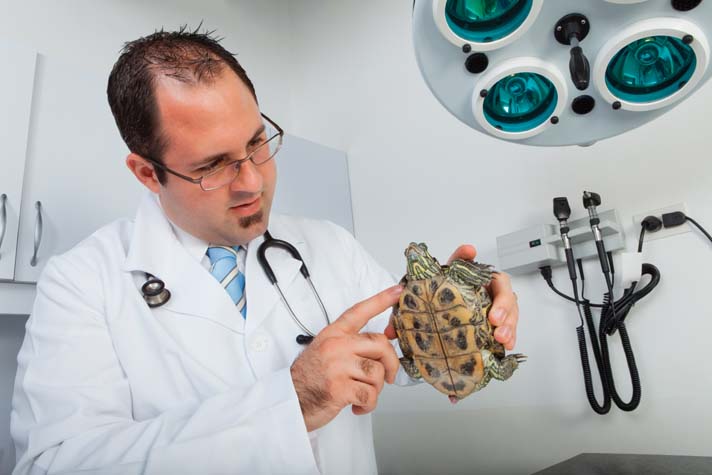
la india piaroa, twin design/shutterstock
Have your turtle examined by a veterinarian at the first sign of ill health, including such symptoms as swollen eyes or a runny nose.
Pet aquatic turtles may become ill, especially if not cared for properly. An annual examination by a veterinarian with experience in turtle care is important. During the examination, the overall health of the turtle can be assessed and any modifications in the turtle’s care can be discussed.
Read More
Keeping a Turtle? Here are Some Tips All New Turtlekeepers Need To Know
The Five Most Important Things To Do When Keeping Aquatic Turtles
Poor diets can result in nutritional diseases, low temperatures can result in a weak immune response, poor water quality can result in eye, skin, and shell problems, and poor lighting can result in weak bones. Even when cared for perfectly, turtles are living organisms that can become ill like any other organism. Signs of illness often include loss of appetite, lethargy, buoyancy problems (e.g., floating sideways), swollen eyes, and runny nose. These signs are not specific to any particular disease, but rather are symptoms of disease. If any of these signs are noted, an appointment should be scheduled to see a veterinarian.
Nutritional Diseases in Aquatic Turtles
Nutritional diseases of turtles have become less common over the past 30 years due to the widespread availability of husbandry information, commercially available turtle diets, and appropriate lighting products.
Classically, “soft shell” (a symptom of nutritional secondary hyperparathyroidism) is caused by inadequate dietary calcium and vitamin D, excessive dietary phosphorus, and lack of ultraviolet light. The disease is most common in young turtles, and symptoms may include a soft shell, broken bones, and weakness. If detected early, the disease is reversible with correction of diet and lighting, while more advanced cases may require prescription supplements. During treatment, if the patient is eating, it should have its diet improved by adding high-calcium food items and a calcium and vitamin D3 supplement. Natural sunlight should be provided, if possible, or UVB artificial lighting.
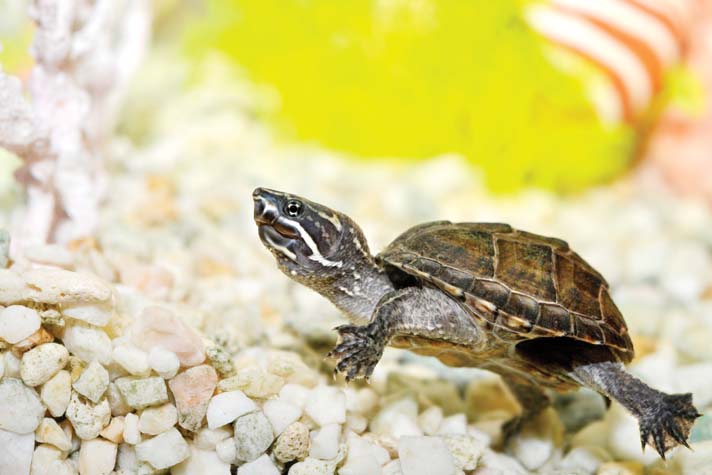
oksankash/shutterstock
Turtles are curious and will eat items, if small enough, that they shouldn’t, including gravel.
Vitamin A deficiency in turtles most often causes swollen eyes. In the past, it was commonly seen in young turtles that were being fed unsupplemented beef, chicken, insects, or iceberg lettuce. This problem has largely been eliminated with the availability of complete pelleted turtle diets.
Treatment is generally effective with vitamin A by prescription. Veterinarians should be careful not to diagnose vitamin A deficiency in an animal that has been on a diet with adequate vitamin A. Often, eye swelling in these specimens is due to a bacterial or viral infection, or exposure to excessively strong UV light.
Infectious Diseases in Aquatic Turtles
Infections are common in aquatic turtles. Organisms such as bacteria and fungi are often part of the normal environmental flora of turtles, and many bacteria are normally found in the mouth and digestive system of aquatic turtles. Sometimes, however, these organisms can enter parts of the body where they should not normally be found, and then infection can develop.
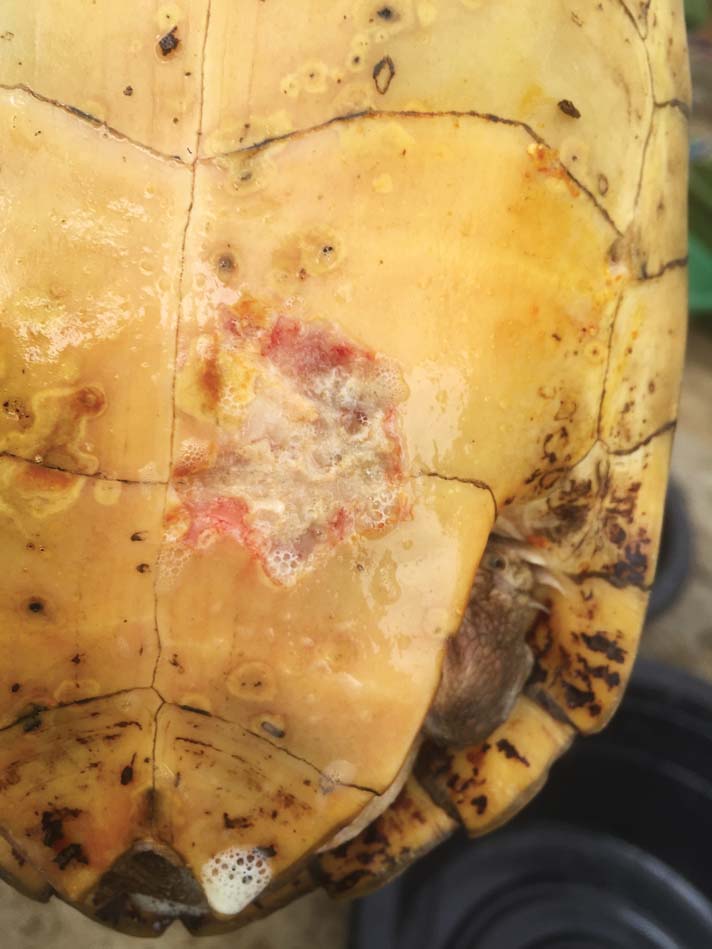
DR. CHARLES INNIS
Figure 1. Deep infection of the bone of the plastron in a Palawan forest turtle (Siebenrockiella leytensis). This image shows the lesion after the infected dead bone was surgically removed.
Turtles often develop infections of the shell, respiratory tract, skin, ears, and digestive tract. In severe cases, infection can spread through the entire body via the circulatory system. Shell infections can range from very mild, superficial infection of the outer keratin layer, to osteomyelitis, which is a deep, severe infection of the bone of the shell (figure 1). Indications of shell infection include discoloration, bleeding, abnormal keratin sloughing, localized softness of the shell, and bad odor. For some species (e.g., painted turtles), it is normal to see shedding of the thin keratin scutes of the shell as the turtle grows, and this should not be confused with infection.
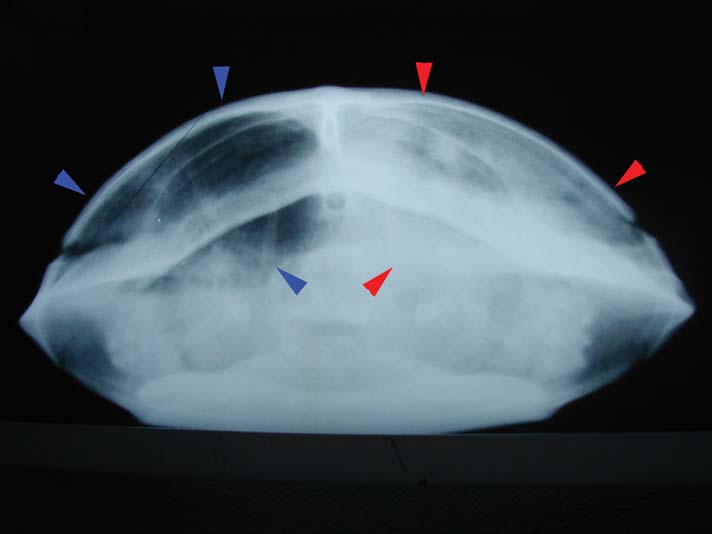
Dr. Charles Innis
Figure 2. This is a radiograph of a red-eared slider turtle affected by severe pneumonia. The turtle is facing the x-ray beam head-on. The normal right lung (blue arrows) is black because it contains air. The infected left lung (red arrows) is white because it contains fluid.
Respiratory infections may range from simple sinus infections to life-threatening pneumonia (figure 2). Ear infection (otitis) causes bulging of the tympanic membrane on the side of the head (figure 3).
Infections of the digestive system, especially parasitic infections, may cause diarrhea or blood in the feces. Numerous internal parasites cause disease in chelonians, often affecting the digestive tract, circulatory system, liver, and kidneys. Specifically, spirorchid trematodes (worms) and protozoans such as Entamoeba may cause significant damage. While some infections remain within the digestive tract, Entamoeba may spread to the kidneys or liver.
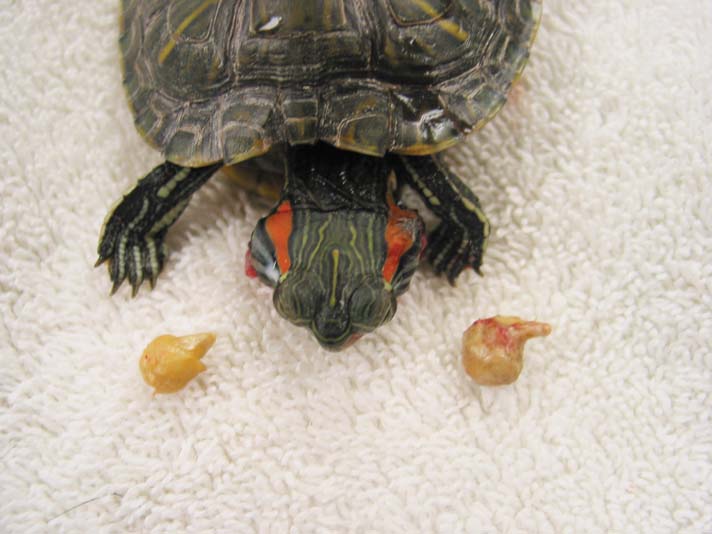
DR. CHARLES INNIS
Infected material has been surgically removed from the ears of this young red-eared slider turtle (Trachemys scripta elegans). This thick, yellow material is typical of reptile infections.
Treatment of infections will depend on the exact diagnosis — for example, which parts of the body are infected, which infectious organisms are involved, and the severity of infection. A complete physical examination and diagnostic testing will allow the veterinarian to develop a treatment plan. Tests such as cultures, fecal parasite analysis, radiographs (x-rays), and biopsies may be required.
For some types of infection, surgery may be needed to remove infected or dead tissue. Medications such as antibiotics, antiparasitics, and antifungals may be delivered by a variety of routes, including topical, oral, injectable, or even nebulized methods. As with all ill reptiles, maintenance of proper environmental temperatures and nutrition is essential during infectious disease treatment.
Reproductive Diseases in Aquatic Turtles
Captive breeding of aquatic chelonians is now fairly commonplace, providing healthy specimens for the pet industry as well as serving an important conservation role for some species. During the course of the reproductive cycle, especially for female turtles, there are numerous opportunities for abnormal processes to occur.
When female turtles reach sexual maturity, they typically begin an annual reproductive cycle, during which follicles on their ovaries become enlarged and filled with yolk. These follicles eventually ovulate and enter the oviducts, where they become the yolks of the eggs. As a follicle passes along the oviduct, the egg white and the egg shell are formed, and the eggs are then ready to be deposited in the ground.
Problems can arise anywhere along this process. In some cases, follicles may fail to ovulate, and instead they remain enlarged (follicular stasis). Over time, static follicles can begin to decompose, leaking yolk material inside the turtle, and leading to a condition called yolk coelomitis.
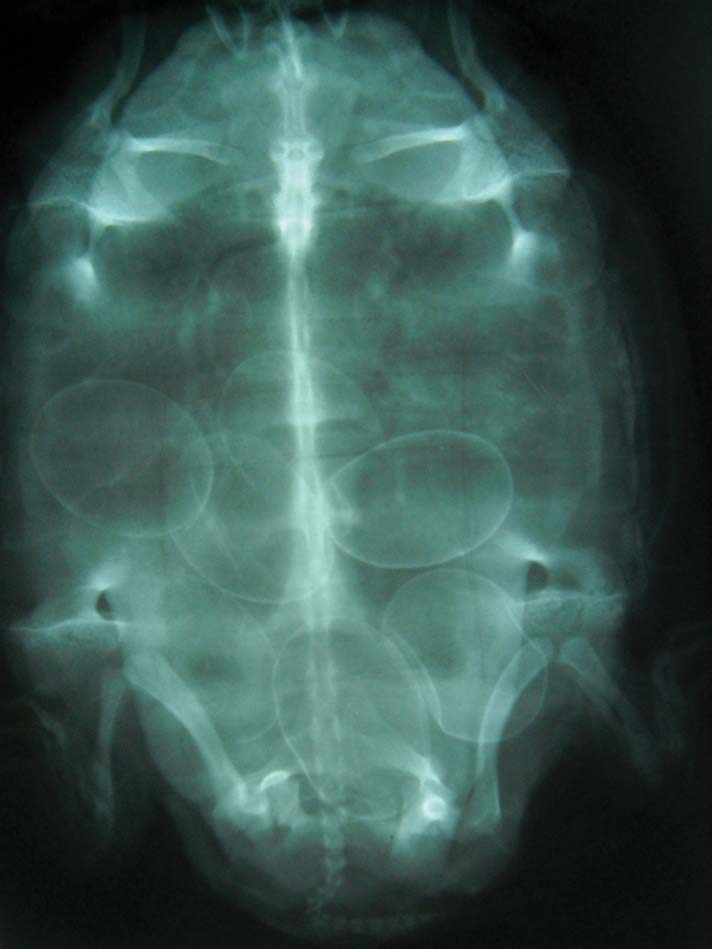
Dr. Charles Innis
Figure 4. This is a radiograph of a common map turtle (Graptemys geographica) with retained eggs that were unable to pass because the pelvis was abnormally narrowed. During surgery, the eggs were successfully removed from the oviducts, urinary bladder, and colon, and the turtle was spayed to prevent future problems.
In other cases, fully shelled eggs are retained too long in the oviducts, where they may become stuck. Rarely, eggs can move into unusual areas of the body, such as the colon or urinary bladder, or even become loose inside the turtle’s body cavity (figure 4).
Fortunately, the diagnosis and management of such conditions has become quite sophisticated in recent years, and many such cases can be managed medically or surgically if the condition is detected soon enough. Principles of minimally invasive surgery are now being applied to turtles, as for humans, and veterinarians can now remove retained eggs and diseased ovaries when needed. It is even possible, and quite reasonable, to have a female turtle spayed before these types of problems arise.
Penis prolapse is sometimes seen in male turtles (figure 5). In general, if you see a fleshy structure extruding from the vent of a male turtle, it is a penis until proven otherwise. Other, more serious conditions, such as intestinal prolapse or oviduct prolapse (in females), can look similar.

DR. CHARLES INNIS
Figure 5. This is a penis prolapse in a young snapping turtle (Chelydra serpentina).
If the extruding structure retracts back inside the vent without incident, you likely have a normal male turtle. Sometimes, though, the penis can become traumatized during breeding attempts (turtles sometimes even try to copulate with anything that looks like a turtle, including rocks). If the penis remains extruded, veterinary intervention is needed. Medical management is used to reduce any swelling, and surgery may be needed to temporarily replace the penis inside the vent.
Sometimes penis amputation must be performed if it cannot be salvaged. The procedure probably renders the turtle infertile, although if the testes have not been removed then sperm production may continue. If a male turtle is not needed for a breeding program, it is possible and practical to have the turtle neutered, if desired.
Foreign Bodies in Aquatic Turtles
Turtles are very curious, and they will often eat anything that is small enough to ingest. Once ingested, items that are not food items are referred to as foreign bodies. Materials such as gravel, coins, and jewelry may be consumed. If the turtle is fairly large relative to the size of the object, foreign bodies may pass through a turtle’s digestive system without incident. But if the objects are large, numerous, or heavy, they may become entrapped in the turtle’s digestive system, causing an obstruction. Obstructions can become life threatening over time, but if detected soon enough, the patient can often be successfully managed by endoscopy or surgery.
Fish hooks are a specific type of foreign body, and while it would be unusual for a pet turtle to ingest a fish hook, hooks are commonly seen in wild aquatic turtles that are presented to rehabilitation centers. The outcome of hook ingestion is quite variable and depends on the type of hook, the location that it has become lodged, and whether there is fishing line attached. In simple cases, a single hook is present in the mouth, where it can be easily removed. In complicated cases, the hook is lodged deep in the esophagus near the base of the heart, and a long length of fishing line extends into the intestines, where it gradually cuts through the intestinal wall.
The management of each case is different, and the veterinarian will use a variety of information to determine how to manage each case.
Trauma in Aquatic Turtles
A pet turtle’s shell may be damaged by a dog, or sometimes by more severe accidents involving, for instance, a lawn mower or vehicular trauma. Some severe cases may warrant euthanasia, but many can be managed successfully with various shell repair techniques. These methods are frequently taught at veterinary and rehabilitation conferences, thus many veterinarians can provide such services.
It is important to recognize that in addition to the obvious shell trauma, there are often more serious problems, such as blood loss, low heart rate, and severe pain. Thus, turtle trauma patients must be thoroughly managed.
Conclusion
There are many other diseases that affect aquatic turtles, but by thoroughly researching the husbandry needs and natural history of each species, turtle keepers can minimize the risk of disease.
As a general rule, a quarantine period lasting at least one month should be applied to any new acquisitions, especially for large, valuable turtle collections. During the quarantine period, an examination and diagnostic testing by a veterinarian can help to detect any contagious diseases. Turtle keepers should be aware of common signs of illness, and should seek veterinary care when such signs are noted.
Dr. Charles Innis has been caring for turtles for 45 years and has bred 10 species in captivity. He is Director of Animal Health at New England Aquarium, past president of the Association of Reptile and Amphibian Veterinarians, and is a board-certified specialist in reptile and amphibian medicine and surgery.



